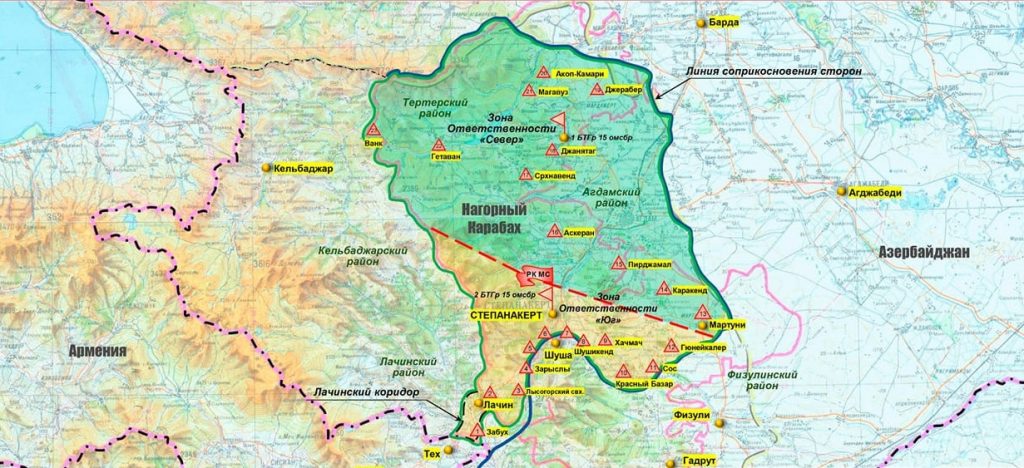Karabakh: Russian and Turkish peacekeepers, Azerbaijani and Armenian military – who’s where
As of November 21, close to 2000 Russian peacekeeping forces have been completely deployed in Nagorno-Karabakh.
Turkish forces will also appear in the region in the coming days. The Aghdam region has already been returned to Azerbaijan and the Azerbaijani army has entered the area. The next to be surrendered are the Kalbajar and Lachin districts.
Refugees are returning to Khankendi (Stepanakert).
The “second Karabakh war” began on September 27, 2020 and was stopped 45 days later – on November 10, after Armenia, Azerbaijan and Russia signed a peace agreement. On the same day, Russian peacekeepers began to enter the region.
What has happened since the signing of the truce?
Area monitored by Russian peacekeepers
The Russian peacekeeping contingent completed its deployment in Nagorno-Karabakh on November 20.
According to Russian Defense Minister Sergei Shoigu, these are mainly units of the 15th separate motorized rifle brigade. In general, 1,960 military and 552 units of equipment are deployed in Nagorno-Karabakh.
The Lachin corridor, which connects Armenia with Khankendi (Stepanakert) and the territory of Nagorno-Karabakh, which remained on the Armenian side, is completely controlled by units of Russian peacekeepers.
There are 23 observation posts here.

The peacekeepers ensure the safe return to Khankendi (Stepanakert) of refugees who left the conflict zone during the days of hostilities. In total, 4,436 people had returned by the time of publication.
The Lachin corridor and the 28 km section of the road to Stepanakert have been cleared, and civil traffic has been opened along it.
Under the supervision of the International Committee of the Red Cross, the bodies of dead servicemen are being exchanged.
By this time, a total of about 400 dead soldiers and officers from both sides had been transferred.
Turkish servicemen prepare to arrive in Karabakh
In the coming days, Turkish servicemen are to arrive in Azerbaijan. The ground forces have already completed the preparatory work, said Turkish National Defense Minister Hulusi Akar.
“We have agreements with Russia. We have done everything in our power to protect the legal rights of our Azerbaijani brothers, and we will continue to work in this direction,” Akar said.
Under the terms of a trilateral agreement signed by the Presidents of Azerbaijan and Russia and the Prime Minister of Armenia, a joint monitoring center will be created with the participation of military personnel from Russia and Turkey.
The center will be located on the territory of Azerbaijan, its exact location will be determined by official Baku.
The tasks of the joint monitoring center include monitoring over the implementation of the terms of the agreement by the peacekeeping forces.
Agdam is returned, Kelbajar and Lachin are waiting
The trilateral agreement provided for the withdrawal of Armenian forces from the three regions and their return to Azerbaijan.
The first region to be given to Azerbaijan was supposed to have been Kalbajar on November 15, but the Armenian side asked Azerbaijan (through Russia) for a postponement due to logistical problems – the region is connected with Armenia by one narrow road, and not all residents of the Kalbajar region had managed to leave it.
The transfer of this area was postponed to 25 November.
The process of transferring the Agdam region to Azerbaijan was completed on November 20. The Azerbaijani army entered the area on the set day.
The Lachin region will be transferred to Azerbaijan on December 1. Currently, the Armenian army and the population of the region are leaving this territory.
The status of Nagorno-Karabakh and the presence of the Russian military – what is argued about in Azerbaijan
The future status of Nagorno-Karabakh, i.e. the part which remained under the control of the Russian peacekeeping forces, is the main topic of debate on Azerbaijani media:
“Everyone is talking about its status… and there are actually two different concepts.
1. This is the final status, which should be the result of a rather lengthy process of settlement, possibly as a result of negotiations, or maybe without them, as happened throughout the territory taken by the Azerbaijani army.
2. Temporary status in the territory taken under the control of the Russian peacekeeping forces, which is a set of military-technical measures and de facto conditions.
Azerbaijan’s position is that this temporary status will ensure the transition to the final status, which implies the restoration of Azerbaijan’s sovereign rights in full.
Therefore, the [Russian] forces, like the Turkish ones, need a mandate that will define their powers and tasks for the period until the final settlement and the achievement of the final status,” former Azerbaijani Foreign Minister Tofig Zulfugarov wrote on his Facebook page.
Main points of the tripartite agreement
• Armenia and Azerbaijan stopped at the positions they occupied by the moment of signing the agreement.
• Russian peacekeepers are to be stationed along the line of contact in Nagorno-Karabakh for at least five years.
• A timetable has been agreed upon according to which Armenia should withdraw its troops and return to Azerbaijan control over the three regions adjacent to Karabakh.
• Refugees are to return to the territory of Nagorno-Karabakh and adjacent areas.
• The parties must exchange prisoners of war.
• All economic and transport links in the region are unblocked.
More about the agreement here.


















